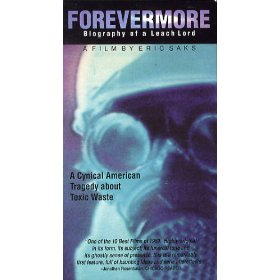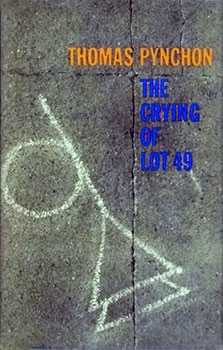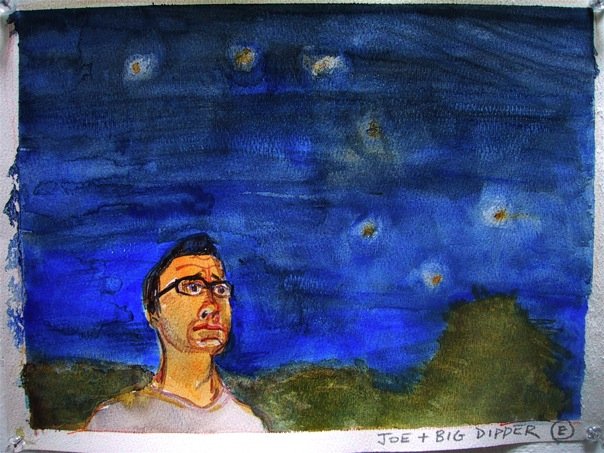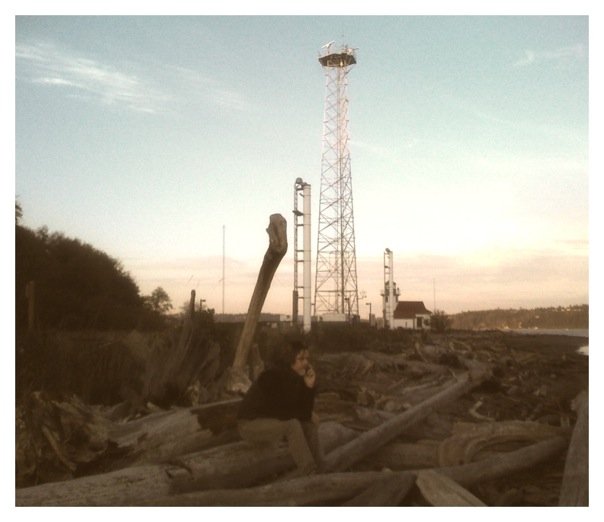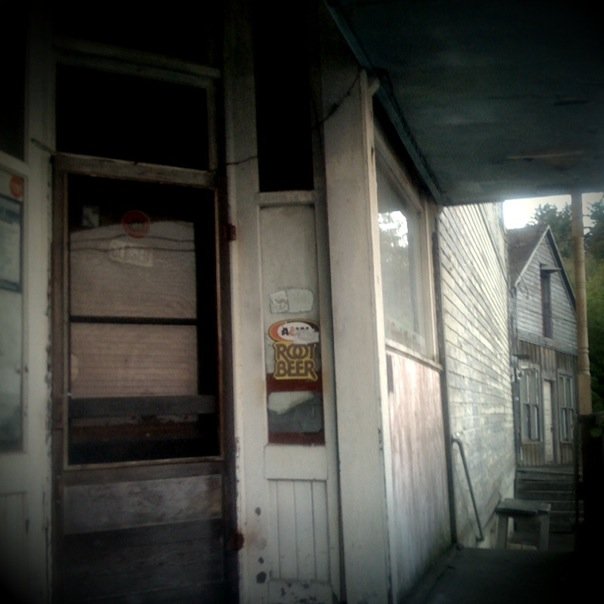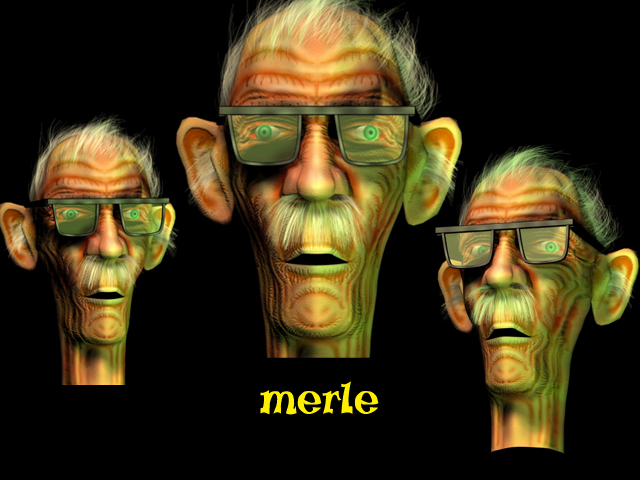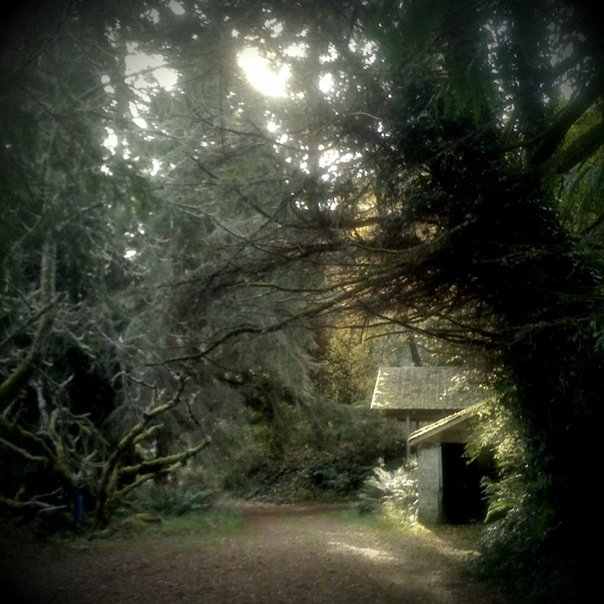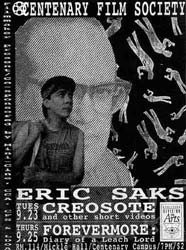From Film Comment, July-August 2001. I’m sorry that I haven’t been able to provide many illustrations for this that are tied to the films and videos discussed. Many of the ones I’ve used are drawn from earlier or later works by Saks, including paintings and photographs. — J.R.
It’s tempting to call Eric Saks’ preferred mode, in video and film alike, the pseudo-documentary — though there are times, mainly during my more apocalyptic moods, when I wonder if any other kind of American documentary currently exists. It’s less speculative to say that two of Saks’ main subjects are ecology and waste, but if you extend the meaning of those terms logically, you come up with just about the entirety of the sad American empire, President George W. Bush included.
Place Saks’ work in a drawer marked “weird stuff” or “marginal,” regardless of whether that drawer stays open or closed, and the gesture becomes the same kind of empty, self-fulfilling market judgment that his work laments — like the current functioning of national boundaries, simply a blind stab at demographics and market research rather than any valid estimation of universality. Yet Saks’ remarkable, neglected early 16mm feature Forevermore: Biography of a Leach Lord (89) and his more recent videos like Creosote and Dust breathe an everyday American desperation that we can all recognize, even when it comes wrapped (as it often does) in a literary tradition — a form of layered, weathered melancholy about American hunger that Thomas Pynchon captured perfectly (albeit in a more hippie-humanist register) on an early page of his 1966 novel The Crying of Lot 49. Mucho Maas, a DJ who once sold used cars, reflects on those abject, essential objects:
“Yet at least he had believed in the cars. Maybe to excess: how could he not, seeing people poorer than him come in, Negro, Mexican, cracker, a parade seven days a week, bringing the most godawful of trade-ins: motorized, metal extensions of themselves, of their families and what their whole lives must be like, out there so naked for anybody, a stranger like himself, to look at, frame cockeyed, rusty underneath, fender repainted in a shade just off enough to depress the value … inside smelling hopelessly of children, supermarket booze, two, sometimes three generations of cigarette smokers, or only of dust — and when the cars were swept out you had to look at the actual residue of these lives, and there was no way of telling what things had been truly refused (when so little he supposed came by that out of fear most of it had to be taken and kept) and what had simply (perhaps tragically) been lost: clipped coupons, promising savings of 5 or 10 cents, trading stamps, pink flyers advertising specials at the markets, butts, tooth-shy combs, help-wanted ads, Yellow Pages torn from the phone book, rags of old underwear or dresses that already were period costumes, for wiping your own breath off the inside of a windshield with so you could see whatever it was, a movie, a woman or car you coveted, a cop who might pull you over just for drill, all the bits and pieces coated uniformly, like a salad of despair, in a gray dressing of ash, condensed exhaust, dust, body wastes — it made him sick to look, but he had to look.”
Or to put it more succinctly and dryly — the way that Isaac Hudak does in his diary, writing at some point in the Seventies — “The great waste debacle is not on top of us, it’s already in us, the soil in our blood.” Hudak is Saks’ fictional toxic-waste dumper, or “leach lord,” recording his thoughts (some of them borrowed from E.M. Cioran and Peter Handke) over half a century in Forevermore — a solitary sad-sack played by three separate actors onscreen, three more actors off (with Saks himself handling the middle years). If you’ve just stumbled over his name while wondering if you’re already supposed to know who he is, then in a way you’ve already entered the treacherous domain of the typical Saks video, where your own uncertainty about what’s real and what’s fiction, what’s fantasy and what’s documentary, what’s science and what’s poetry, is part and parcel of the confusion and isolation being addressed — the comedy and terror of not knowing who and where we are.
The eleven Saks works I’ve seen since Forevermore, made over a span of a dozen years, are all videos — or at least that’s what they were when I saw them, some of them having assumed other forms on earlier occasions: Don from Lakewood (which had previous lives, first as a picture book and audiocassette, then as a live performance piece and puppet show; 89), You Talk/I Buy (90), Hide (90), Gun Talk (91), Fax Attack (a three-minute documentation of anarchist mischief — getting even with restaurants who fax unwanted menus by faxing back reams of meaningless items in loops; 92), KNBR (93), Straight Talk About Deserts (94), Neglectosphere (documentation of surreptitious pseudo-surveillance devices installed by Patrick Tierney, a frequent Saks collaborator, in municipal buildings in Torrance, California, 95), Touch Tone (apparently also available in a graphic novel version; 95), Creosote (97), and Dust (a collaboration with Michael Goedecke and the collective Belief EXP excerpted from a video installation consisting of a DVD video loop projection with a sound system, 00).
The first three are (or were) commercially available on a single video from Videoactive Releasing. Collectively they suggest the kind of ongoing madcap quarrel with capitalism and technology Saks is engaged with, displaying a form of mutual aggression in which everyone loses, sellers and buyers alike. Don from Lakewood — the best known and meatiest of the trio, another joint effort with Tierney — is, like I Talk/You Buy, partially shot on the now-almost-extinct Fisher-Price Pixelvision video format that Sadie Benning and Michael Almereyda have helped to make famous, yielding a grainy, intimate image, black-and-white and boxed in. But the soundtrack — chronicling a series of real phone chats between a used sofa salesman named Willy and a persistent potential customer calling himself “Don from Lakewood” who refuses to come by the store — is much more important than the visuals. It’s an absurdist, Beckett-like combination of the simultaneously deadpan hilarious and the interminable; as one catalog description of the piece puts it, “The salesman and the customer have talk and no communication.”
In the first call, Don is requesting a catalog, insisting he can’t get out of the house, and Willy’s replying with infinite patience that it makes no sense for him to produce a catalog detailing the used sofas he currently has in stock. In a second call, Don asks if someone else can pick up a sofa for him on spec with a $10 deposit, assuring Willy that the guy he’s sending along is a good Christian; Willy patiently explains that he’s being evicted at the moment and can’t help him out. And in a third call, when Willy claims he’s still being evicted, Don proposes coming by the store late at night to look at a sofa. Willy says he has only one sofa left and it can’t be seen from the window; he adds that he can’t open the store for Don at 2 AM or leave a key to the store for him to pick up because he has neither the time nor the inclination to do business in this manner. Meanwhile, what we see is even more minimalist: a silhouetted puppet with a dangling phone line standing in for Willy, a crudely animated drawing for Don, and some funky animation about driving down a road between the calls.
In the similar stretch of sales talk and response comprising You Talk/I Buy, the visuals are more abstract, obscure, and nightmarish, with aggressive flicker effects that threaten to produce hallucinations. And Gun Talk (or, rather, Part One of a video that has a 1995 sequel), performed as well as directed by Saks, in a way does for gun worship what the previous videos do for retail, though the pop representations are generally more abusive (sliding and bouncing magazine and newspaper cutouts, with the Nancy comic strip’s Sluggo a featured player) and the discourses more varied (personal confessions of gun traumas spoken by Saks behind various masks; glib, horrific maxims delivered by electronically generated voices that recall Alphaville’s Alpha-60 — e.g., “If a boy can go down to a 7-11 with $10 and a list of groceries and then come back with the right change, he’s old enough to learn how to handle a handgun.”)
KNPR may be the first item in this bunch to give us a prolonged look at Torrance, the L.A. suburb figuring as a Saks axiom and staple. It juggles a scrapbook history of a local bus line, diverse home movies, a surreal and fatuous DJ patter improvised by Tierney, cryptic intertitles (“Sunday/misty romance of the Near East/in your own back yard”), and the tackiest organ music imaginable, recorded at varying speeds. The collage effect may recall some of John Dos Passos’ newsreels in U.S.A. (or Fibber McGee and Molly on acid), but the ominous tone suggests some sort of truce between normality and derangement that becomes increasingly sinister, calling to mind Norman Mailer’s early evocation of Naked Lunch: “The joy in reading is equal to the kick of watching a television announcer go insane before your eyes and start to croon obscenely about the President, First Lady, Barry Goldwater, Cardinal Spellman, J. Edgar. Somewhere in America somebody would take out his pistol and shoot the Set.”
Approaching this project more formally, Straight Talk About Deserts combines the collage method of filmmaker Lewis Klahr with a few nasty tweaks. An anchorwoman seen on a toy TV set starts giving spastic raspberries in the midst of a newscast while the image subdivides into different colored sections. Over slipping and sliding landscapes and flapping insects, the alienation effects come fast and hard, each voice interrupting or overlapping its predecessor. (There are also many overlaps between videos. Touch Tone — introducing the dust that comes back as a featured player five years later, in Dust — also picks up the alienated and/or interrupted phone talk while offering comparable kinds of fragmentation in the poisonous pop images.)
Creosote and Dust, creepy and ambitious recent works, throw all sorts of refuse into the mix. The former — slowly unraveling in stark black-and-white and spooky multiple exposure, using stop-frame animation and puppets — recounts a fractured narrative as scary as any of the millennial visions found in Don DeLillo’s Underworld. The main strands are abstracted from two stories of real-life figures — Jared Negrete, a Boy Scout who mysteriously disappeared forever on a camping trip, and St. Francis of Assisi — though the character named in an intertitle (also voiced by a female narrator) is an amalgamation of the two, “Francis Negretinez.” For Saks, Creosote stems from “several desires: to create a work that connects violence in the family to the spiritual crisis of the end of this century; to juxtapose the prototypical drifter with a religious visionary; to continue with a body of media-work relating to the dramas of the California desert; to accept visions as real and meaningful.” That’s a lot to take on, even in 42 minutes, and if the work yields dark moods as much as visions, a sense of impending doom is a constant.
Dust suggests a Jackson Pollock working with junk rather than paint — an action canvas made up of dust motes, static, airwaves, broken bits of chatter. Finding our way through this splatter may be beyond our means, but at least Saks offers an instructive way of getting lost. Perhaps the purest example of his art to date, this half-hour video has a perpetual fascination deriving from a rather terrifying dialectic between image (particles of drifting dust) and sound (conversational voices heard in intercepted and surreptitiously recorded phone calls).
What becomes frightening — posthumanist with a vengeance — is that contrary to expectations, it’s the dozens of voices and not the millions of motes that wind up seeming interchangeable. At least in terms of form, no two specks are alike, and their spontaneous flux is obvious from one second to the next as they drift by in diverse patterns.
At first the chaotic confetti spill of disconnected raps on the soundtrack seem informed by diverse kinds of content — a father mishearing his daughter each time she says “lizard” and many other apparently random bits. But then instances of phone sex or talk about sex start to accumulate so relentlessly that the rare deviations from this norm — such as two women chatting about farting and defecating in public or one guy’s equally un-self conscious lament of depression about his domestic life — ultimately sound no less estranged or mechanical.
And it keeps getting worse: the words turn phonier as they fall into similar patterns of cultural regimentation (“You’ve just earned major karmic credit points for not playing games and for telling the truth”), while democratic dust registers as more and more exhilarating in its freedom and diversity, mocking our sameness. It eerily evokes the notion of cockroaches outliving destructive humanity, marching intact through the apocalypse — a denouement one suspects Saks might relish.

